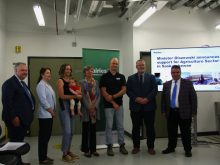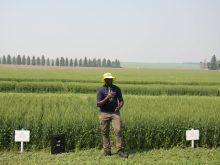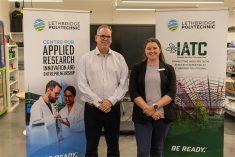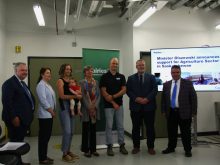The range is where the deer and the antelope play.
It’s also where Walter Willms has studied for more than 40 years, and where the renowned Agriculture Canada researcher in range ecology and management has uttered that seldom heard discouraging word about grazing systems.
They aren’t all they’re cracked up to be, he says.
He and some colleagues once published a research paper that challenged ideas on commonly accepted rest-and-graze approaches. It made waves in research circles.
“We got a lot of flack from many people, which kind of tickles my fancy, because if we’re not shaking up the paradigm, then we really aren’t accomplishing a lot. We’re just going with the flow,” says Willms.
Read Also

Farmers asked to keep an eye out for space junk
Farmers and landowners east of Saskatoon are asked to watch for possible debris in their fields after the re-entry of a satellite in late September.
Though some may consider the world of native range to be peaceful, Willms takes obvious delight in polite disturbance.
“I’ve done a lot of questioning, and there’s usually a basis for it. I wasn’t doing it just to be ornery, but some people might think so. But it’s been a lot of fun.”
Willms, 67, plans to retire later this year, having amassed a body of work that makes him Canada’s preeminent rangeland research scientist. He has the most senior classification within the country’s agriculture research network, that of principle research scientist.
The extent and quality of his research recently led his colleagues to successfully nominate him for the W.R. Chapline Research Award, which is presented by the Society for Range Management.
He received the award Feb. 1. The plaque sits on the window ledge of his Lethbridge office among papers and flotsam amassed from rangeland in southern Alberta and from Inner Mongolia, where he has also conducted research and helped Chinese colleagues develop their own studies.
Barry Adams, head of the rangeland resource management program with Alberta Agriculture, was mentored by Willms and remains an admirer.
He recalls Willms’ controversial questioning of grazing systems and the quality of the science that generated commonly accepted range management principles.
“To have anybody come along and question these pillars of wisdom actually produced a lot of very angry debate in certain areas,” Adams recalls.
But that was only one of the many questions Willms asked over the years. His inquiries resulted in greater understanding about the value of organic litter on range and contributed to general understanding of winter grazing, Adams says.
“Sometimes we can understand how things work in practice, but we don’t always understand how they work in theory. And sometimes it’s having that underlying theory that helps to kind of defend or promote those practices.”
Willms’ work provided that theory.
However, with the humility that Adams says is characteristic of the researcher, Willms doesn’t give particular emphasis to his results when he discusses his work. The pursuit of answers is his focus.
Willms is gratified that the value of native rangeland is better recognized than in the past, when it was designated by Agriculture Canada as “unimproved pasture.”
“Really, it’s the opposite. As soon as you cultivate it, you are putting that land and soil at risk. You are putting the productivity at risk,” says Willms.
In 2006, the designation changed to “natural grassland.”
A public outcry last year over plans to cultivate natural grassland near Bow Island, Alta., told Willms that attitudes are changing.
“I was pleased to see there was a big outcry, which indicates to me that the public understands the value of this piece of land and they want to keep it. And really, we don’t have very many big blocks of native rangeland (left.)”
Fragmentation is the biggest threat to remaining prairie, says Willms. He estimates only 30 percent of it remains in Alberta, and less than that in Saskatchewan.
Most of his studies have involved fescue grasslands in the Stavely, Alta., area in the southwest and the mixed prairie around Onefour in the southeast.
At the start of his career, Willms planned to become a wildlife biologist. But he fell in love with rangeland after obtaining his masters degree.
“I really think I’ve had the most interesting job that anybody could have. I feel very, very fortunate, it was just a lot of fun,” he says.
“The nice thing about range is that any question you can ask, you can address it through range.”
He is now involved in an extensive study of how cattle engineer grasslands by selective grazing and creation of forage patches that provide habitat for various species.
The study began in 2002 with the goal of providing greater understanding about animal response to changes in grassland structure.
Willms refers often to his mentors and colleagues in the field, among them Silver Smoliak and John Dormaar.
But Willms’ own name is on a massive body of research now in use.
“When you go to any conference or workshop that deals with our ecosystems here in Western Canada, the findings, the results of Walter’s work are always part of the discussion,” says Adams.
He wonders how the work of his mentor will carry on after Willms’ retirement.
“That’s one of the things we need to look to now, to see how Agriculture Canada will continue to ensure this legacy continues.”


















